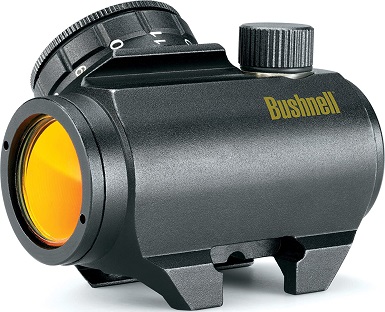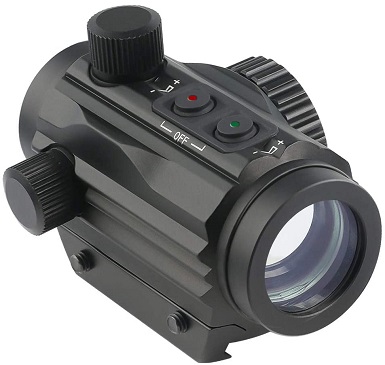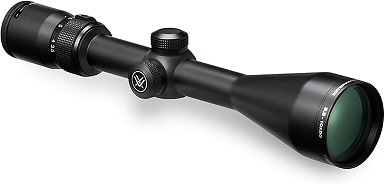10 Best Shotgun Scopes in 2025 – Reviews & Top Picks
Last Updated on

Whether you’re looking for a scope for home defense or to help you hit that turkey on your next hunting trip, getting the right scope is key.
That’s why we took the time to track down the best shotgun scopes out there. If you’re trying to keep your family safe or put food on the table, we’ve got you covered.
Keep reading, and we’ll break down the best shotgun scopes out there before giving you a comprehensive breakdown of everything you need to know about shotgun scopes to help you make your choice.
These are the best shotgun scopes out there, don’t settle for anything less.

A Quick Comparison of Our Favorites
| Image | Product | Details | ||
|---|---|---|---|---|
| Best Overall |
 |
Bushnell Trophy Red Dot Sight Riflescope |
|
CHECK PRICE |
| Best Value |
 |
Two 1x22mm 5 MOA Red Green Dot Sight |
|
CHECK PRICE |
| Premium Choice |
 |
Leupold VX-Freedom 3-9x40mm Riflescope |
|
CHECK PRICE |
 |
Feyachi RS-30 Reflex Reticle Scope |
|
CHECK PRICE | |
 |
Predator V2 Reflex Sight Rifle Scope |
|
CHECK PRICE |
The 10 Best Shotgun Scope – Reviews 2025
1. Bushnell Trophy Red Dot Sight Riflescope – Best Overall

When you’re looking for the best reflex sight for your shotgun, you can start and end your search with the Bushnell Trophy Red Dot Sight. It’s the perfect mix of affordability and performance and does everything you could want from a reflex sight.
There are 11 different brightness settings to choose from, so finding your reticle is never a concern, even in the brightest or dimmest conditions. This scope mounts on rifles, shotguns, and handguns, so if you’re looking for one scope that can fit all your weapons, this is a great choice.
Moreover, you get unrivaled clarity and unlimited eye relief. The only drawback to his scope is that it only comes with a 1x magnification setting, but that’s precisely what you can expect from a reflex sight.
- It’s a great mix of affordability and performance
- 11 brightness settings
- Mounts on shotguns, rifles, and handguns
- Great clarity
- It only comes with a 1x magnification
2. Two 1x22mm 5 MOA Red Green Dot Sight – Best Value

If you’re looking for the best shotgun scope for the money, the Two 5 MOA Red/Green Dot Sight is exactly what you want. It’s incredibly affordable, but that doesn’t mean you’re getting a low-quality scope.
Not only do you get an unlimited field of view, but you also have seven different brightness levels to choose from. Moreover, you get two different reticle color choices, red and green. So, no matter what you’re trying to aim at, you can easily find your reticle and line up your shot.
But there are two different drawbacks to this scope. First, it’s difficult to make windage and elevation adjustments. In fact, you’ll need to utilize the Allen key any time you want to make adjustments. Furthermore, while you get unlimited eye relief with many red dot sights, that’s simply not the case here.
In fact, it’s a sharp eye relief that can be more than a little frustrating when you’re using this scope. For that reason alone, we couldn’t make it our top pick.
- Very affordably priced
- Two reticle colors – red and green
- Unlimited field of view
- Seven brightness settings
- Challenging to make windage and elevation adjustments
- Sharp eye relief
3. Leupold VX-Freedom 3-9x40mm Riflescope – Premium Choice

Few companies produce more dependable and better-performing scopes than Leupold. That’s certainly true with their VX-Freedom scope line.
Like all Leupold products, it comes with a lifetime warranty, which gives you peace of mind that you’re not going to be stuck replacing this scope in a few years.
However, if you’re looking for an affordable shotgun scope that you can use for home defense or quick target acquisition, this isn’t it. The minimum magnification is 3x – while that’s great for hunting and other outdoor applications, it’s not what you want for home defense.
As long as you know what you’re getting, it’s a great choice. You can easily make windage and elevation adjustments, and the twilight light management system gives you ten extra minutes of light through your scope after the sunsets.
- Lifetime warranty
- Wide magnification range – 3x to 9x
- The twilight light management system gives you ten extra minutes of light
- Easy windage and elevation adjustments
- Expensive for a shotgun scope
- No 1x magnification
4. Feyachi RS-30 Reflex Reticle Scope

The Feyachi RS-30 Reflex Reticle Scope is another excellent choice for an affordable price. The reflex scope has four different reticle options that you can cycle through. Whether it’s personal preference or adapting your reticle to the situation, it’s never been easier to switch to what you need.
Moreover, five different brightness settings allow you to optimize your battery life while still ensuring that you can see your reticle at all times. Additionally, you get unlimited eye relief and excellent clarity with this scope.
However, it’s not perfect, and that’s why it’s not our top choice. First, you’re stuck with a 1x magnification, but that’s what you can expect from a reflex sight. More important is the fact that you can’t make any windage or elevation adjustments without a hex key.
- Four reticles you can cycle through
- Five brightness settings to choose from
- Unlimited eye relief
- Affordably priced
- Only 1x magnification
- You need tools to make elevation and windage adjustments
5. Predator V2 Reflex Sight Rifle Scope

This is another affordable reflex sight, but it’s simply not as nice as the options higher up on our list. While it does offer a lifetime warranty, Predator won’t cover the issues you’re going to run into.
That’s because the primary complaints with this scope are blurry reticles and the fact that you can’t make elevation and windage adjustments without tools.
These are both conditions of the scope, and the warranty won’t fix them. However, you do get four different reticle styles to choose from. Moreover, you can switch between a green and a red light. While those aren’t the most impressive features for a reflex scope, they are still nice to have.
- Affordably priced
- Lifetime warranty
- Four reticle styles to choose from
- Two-color settings to choose from
- Some reticle settings give blurry reticles
- Tools needed for elevation and windage adjustments
6. Vortex Optics Diamondback Second Focal Plane Riflescopes

Vortex Optics makes phenomenal scopes, and their Diamondback Second Focal Plane Scopes are no different. Much like the Leupold scope we reviewed above, this is a scope that you’re going to want for hunting, not home defense.
While it doesn’t have a true 1x magnification setting, the minimum magnification of 1.8x means that you won’t have any problems hitting close-range targets. However, you’ll still get the advantages of a scope with a maximum magnification of 5x.
Moreover, it’s easy to make both windage and elevation adjustments. It doesn’t matter what you’re hunting – with a Vortex Optics Diamondback scope, you’re in good hands.
The best part is that all Vortex Optics scopes come with a lifetime warranty, so you don’t have to worry about this scope giving out on you in just a few years.
- Good magnification range 1.8x to 5x
- Lifetime warranty
- Easy to make elevation and windage adjustments
- Fast focus eyepiece is excellent for making quick adjustments
- No 1x magnification setting
- More expensive option
- Better for hunting than home defense
7. OTW RS-25 1x22x33mm Reflex Red Dot Sight Scope

There are tons of things to love about the OTW Reflex Red Dot Sight. For starters, it has a very affordable price tag. But more important is the features that it offers. First, you get four different reticle styles to choose from, and they all perform admirably well.
Second, the sight has a coating of anti-reflective compounds, which gives you an ultra-bright display, even in low-light conditions. Moreover, it’s an extremely durable sight. It can handle up to 800Gs of recoil impact, which is more than enough for most shotguns.
However, while there are plenty of things to love about this site, there is one critical design flaw. That’s the fact that the emitter is open to the elements. This means it can quickly become obstructed, which will prevent you from making your shot when you need it the most.
It’s great for target practice, but if you plan on taking it anywhere else, you’ll have to be a little more careful.
- Affordably priced
- Four reticle styles to choose from
- Anti-reflective compounds on glass for bright displays
- Certified for up to 800G’s of recoil impact
- Open emitter design can quickly become obstructed
- You might also like: 10 Best Scopes for .308 Rifles – Reviews & Top Picks
8. AT3 Tactical RD-50 Micro Reflex Red Dot Sight Scope

The AT3 Tactical Micro Reflex Red Dot Sight excels in a few different areas. For starters, you get a lifetime warranty, so you can rest easy knowing that this is the last scope that you’ll need to buy. From there, you get 11 different brightness settings that make it easy to see your reticle in any condition.
Moreover, you get a multi-coated amber lens that gives you unrivaled image clarity. Finally, like most reflex sights, you get unlimited eye relief, which allows you to hone in on your target and take your shot quickly.
But, while the AT3 Tactical Micro Reflex Red Dot Sight is an outstanding choice for most applications, you’ll have to make sure to keep some extra batteries handy and pay a little more upfront. It’s not that it’s a lousy scope – it’s that it’s not hard to find a better one for less money.
- 11 brightness settings
- Multi-coated amber lens provides optimal image clarity
- Lifetime warranty
- Unlimited eye relief
- More expensive for a reflex sight
- Battery life isn’t nearly as good as the company claims
9. Konus 7249 Shotgun Black Powder Riflescope

The Knous Shotgun Black Powder Scope isn’t a bad scope, but it’s not the best option you have. The magnification settings range from 1.5x to 5x, which is great for hunting applications.
However, the 3″ eye relief is harsh for a rifle scope, let alone one for a shotgun. They call it the Black Powder scope, but if you’re not careful, it’ll turn into the Black Eye scope.
If you do master the limited eye relief, you’ll get a scope that works great in low light settings, and it’s easy to make windage and elevation adjustments. And while it’s not the most expensive scope out there, it’s not hard to find a better scope for less money.
- Good magnification range 1.5x to 5x
- Works great in low-light settings
- Easy to make elevation and windage adjustments
- No 1x magnification setting
- Sharp eye relief
- Expensive for what you get
10. TRUGLO 4x32mm Compact Shotgun Scope

If you’re looking for a scope that you can see through for an affordable price, then this isn’t a bad choice. For those interested in hitting what they’re aiming at and having an enjoyable experience, keep looking.
While you should primarily use this scope for hunting applications, it doesn’t belong in the same conversation as a Leupold or the Vortex Optics scopes we reviewed earlier. For starters, you have to deal with sharp eye relief.
When you’re mounting your scope onto a shotgun, that’s especially troubling as you know they’re known for their excessive recoil. But just as important is the fact that this scope doesn’t do anything to help you see through it in low-light settings.
No extra coatings on the lens, no illuminated reticle, no aid of any kind. It’s low-priced, but it’s low quality too – look elsewhere.
- Low priced
- Excellent brightness, color, and clarity
- Minimum magnification is 4x
- Harsh eye relief
- Hard to see through in low-light settings

Buyer’s Guide – Finding the Best Shotgun Scope
We know that when you’re picking out your shotgun scope, you’re bound to have a few questions. That’s why we broke down the essentials here, that way, you can focus on finding the perfect shotgun scope after you know precisely what you need.
Home Defense vs. Hunting
There are a few different reasons you might want a shotgun scope, but two of the most common are hunting and home defense. And the truth is that you likely want a different scope for each application.
For home defense, you want a reflex sight. For starters, these scopes give you quick target acquisition and provide unlimited eye relief. This has tons of advantages in home defense situations when you need to quickly lock onto your target without losing peripheral vision.
However, if you’re hunting, range suddenly becomes more of a concern. That’s why a traditional rifle scope with a low magnification setting is ideal. You’re not going to be shooting targets 500 yards away with a shotgun, but if you get the right scope, you should be able to hit something between 70 and 100 yards.
The tradeoff for this extra magnification is that it takes longer to zero in on your targets, even while you can make elevation and windage adjustments far quicker. Moreover, you’re going to lose some eye relief, and you’re going to lose a lot of peripheral vision.
These factors don’t matter all that much while you’re hunting, but it makes a big difference when using them for close-range applications.
What About Sport Shooting?
The style scope you need for sport shooting all depends on your specific application. If you’re skeet shooting, it’s going to be a little different than if you’re target shooting.
That’s because skeet shooting relies on quick target acquisition and great aim. However, if you’re target shooting, you can take a little more time when narrowing down your target. Know your sport, know what the competition is using and stick with a similar design.
How Much Eye Relief Do You Need?
While you want adequate eye relief no matter what you’re shooting, when you’re shooting a high-powered shotgun, eye relief becomes even more critical.
Eye relief refers to the distance between your eye and the lens of your scope that you need to see through it. With higher magnification, you get less eye relief, which can be a significant concern with a shotgun.
That’s because if you get too close to the scope, the recoil will send it straight into your eye. The good news is that most reflex sights offer unlimited eye relief, so you don’t have to worry about getting too close to the sight to see through it.
However, if you’re utilizing a traditional rifle scope on your shotgun, you have to be especially careful. Ideally, you want a shotgun scope with at least 4 inches of eye relief to ensure that you don’t give yourself a black eye.
While you can get by with less eye relief if you have a little more experience, just know what you’re getting into before you make any purchases.

Elevation and Windage Adjustments
While every scope that we reviewed here allows you to make both elevation and windage adjustments, the difference is in how easy it is to make those adjustments.
Most reflex sights require that you make the adjustments with tools, which slows down the process and means that you can’t make quick adjustments between shots.
While this might seem like a significant drawback, when you consider that you’re typically only taking close-range shots with these scopes, it’s not that big of a deal.
However, with the traditional scopes, you’ll notice that these adjustments are much easier to make. This is important because you’re using these scopes to shoot things that are farther away, and if you’re going to hit your target, you need to make the right adjustments for everything.
Reticle Styles
While there are various reticle styles you can choose from, there’s a big difference between a red dot reticle and a reticle on a traditional scope.
Red dot reticles are typically, but not always, point and shoot. You put the dot on the target, pull the trigger, and hope you hit. It’s an extremely straightforward way to shoot, and as long as the target is close enough, you’re good to go.
However, if you’re hunting, you’ll have to learn to use a traditional reticle to aim your shot and hit your target. That’s because as soon as you start shooting something a little farther away, you have to worry about gravity, windage, and elevation.
That’s where these advanced reticles shine. Learn how to use them, and you’ll be in far better shape the next time you head out.
How Much Brightness Do You Need?
Brightness matters when you’re shooting in low-light settings. But once again, you’ll have to make a distinction between a reflex sight and a traditional scope here.
For a reflex sight, as long as you can see the reticle, you’re typically good to go. You’re not shooting distance targets, and you’re not typically losing a lot of light from your surroundings. This all breaks down to a sight that’s relatively easy to see and use.
However, if you’re using a traditional sight you need to prioritize brightness a bit more. Not only do you need to consider an illuminated reticle, but you should also consider specialized designs that bring more light into the lens.
Features like Leupold’s Twilight Light Management System can be all the difference between seeing your target and making your shot and missing completely.
Quality Matters
When you’re picking out your shotgun scope, go with a quality brand you can trust. While Bushnell earned our top choice here, Leupold and Vortex Optics are phenomenal choices too.
While we only highlighted reputable brands here, there’s plenty of choices out there that are just waiting to rip you off. What’s important is that you do your research.
While you might be able to save a few bucks upfront with a low-quality optic, when you’re missing your shots and they’re breaking after just a few uses, you’ll wish that you would’ve gotten the right scope the first time.

Conclusion
When you aim your shotgun, you want your bullets to go precisely where you’re aiming. While it might seem like a pretty straightforward process, we know that there are tons of questions that come up, and you want to get it right the first time.
That’s why we took the time to come up with a comprehensive review of shotgun scopes and broke down everything you need to know before you make your purchases. Hopefully, this guide gave you enough confidence to purchase the shotgun scope you need to get the job done!
Featured Image Credit: Santipong Srikhamta, Shutterstock
Table of Contents
- A Quick Comparison of Our Favorites
- The 10 Best Shotgun Scope – Reviews 2025
- 1. Bushnell Trophy Red Dot Sight Riflescope – Best Overall
- 2. Two 1x22mm 5 MOA Red Green Dot Sight – Best Value
- 3. Leupold VX-Freedom 3-9x40mm Riflescope – Premium Choice
- 4. Feyachi RS-30 Reflex Reticle Scope
- 5. Predator V2 Reflex Sight Rifle Scope
- 6. Vortex Optics Diamondback Second Focal Plane Riflescopes
- 7. OTW RS-25 1x22x33mm Reflex Red Dot Sight Scope
- 8. AT3 Tactical RD-50 Micro Reflex Red Dot Sight Scope
- 9. Konus 7249 Shotgun Black Powder Riflescope
- 10. TRUGLO 4x32mm Compact Shotgun Scope
- Buyer’s Guide – Finding the Best Shotgun Scope
- Conclusion
About the Author Robert Sparks
Robert’s obsession with all things optical started early in life, when his optician father would bring home prototypes for Robert to play with. Nowadays, Robert is dedicated to helping others find the right optics for their needs. His hobbies include astronomy, astrophysics, and model building. Originally from Newark, NJ, he resides in Santa Fe, New Mexico, where the nighttime skies are filled with glittering stars.
Related Articles:
How to Clean a Refractor Telescope: Step-by-Step Guide
How to Clean a Telescope Eyepiece: Step-by-Step Guide
How to Clean a Rifle Scope: 8 Expert Tips
Monocular vs Telescope: Differences Explained (With Pictures)
What Is a Monocular Used For? 8 Common Functions
How to Clean a Telescope Mirror: 8 Expert Tips
Brightfield vs Phase Contrast Microscopy: The Differences Explained
SkyCamHD Drone Review: Pros, Cons, FAQ, & Verdict



